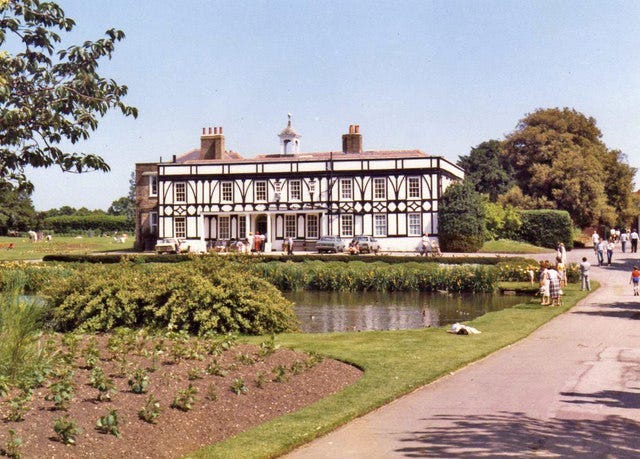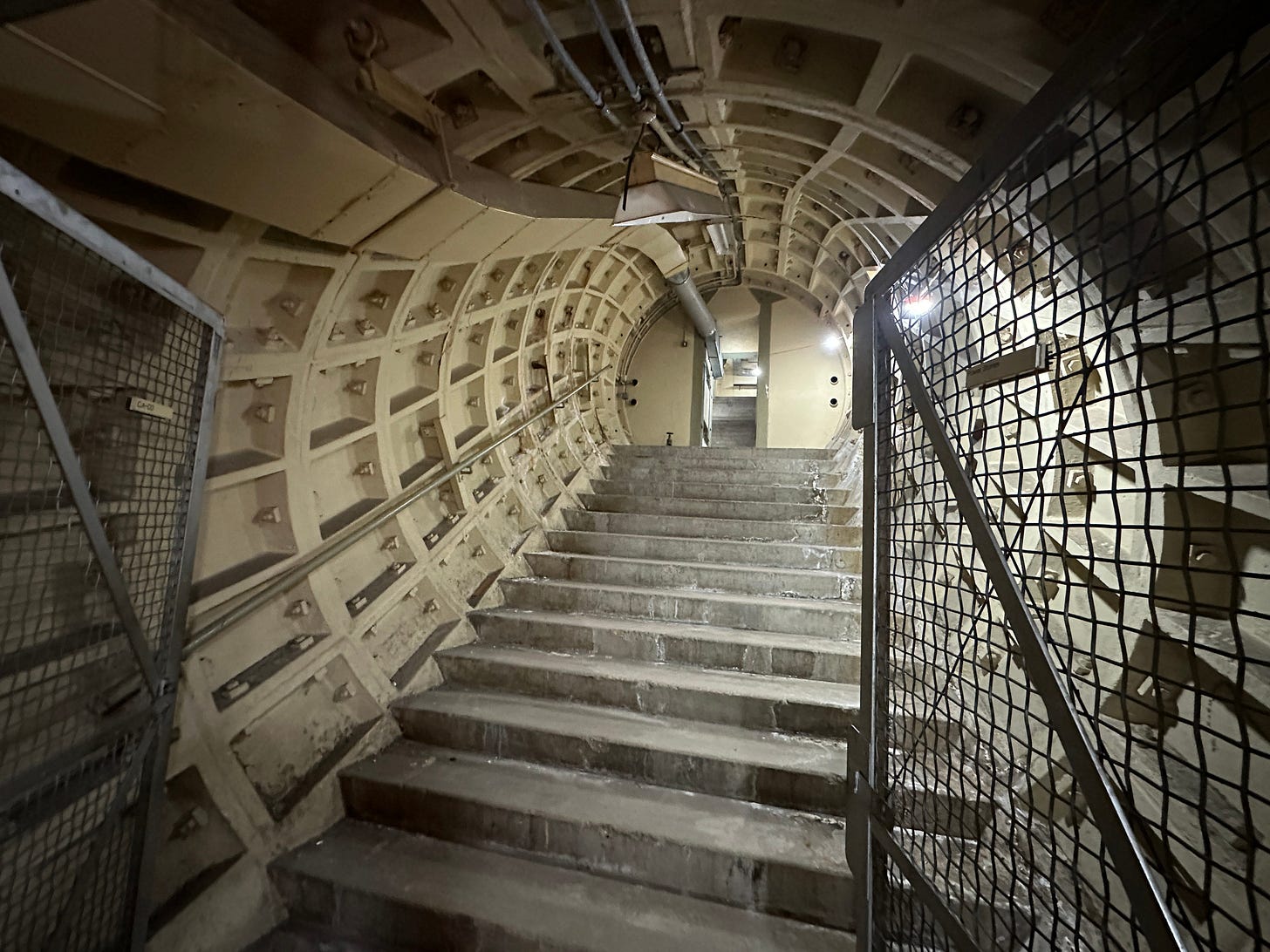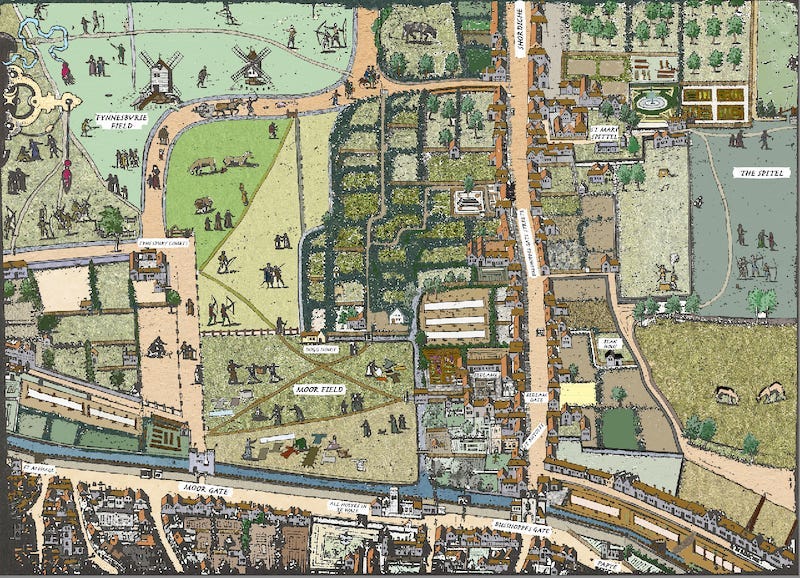The Biggest Stories From Two Years of Londonist: Time Machine
The top 10 stories you read the most.
Welcome to Londonist: Time Machine, the newsletter for London history.
We’re two years old! I’m so, so grateful to everybody who has read and commented on Londonist: Time Machine over the past couple of years, especially those of you make it all possible by taking out a paid subscription.
To celebrate the second birthday, I thought it’d be interesting to look back through the archive to see which stories were most popular. As per tradition, I present this as a Top 10, in reverse order — as ranked by most views.
Note: articles in the archive are usually paywalled, but I’ve removed that barrier for a few weeks so you can read the full articles.
Let’s get stuck in:
10. The Forgotten Square of Bloomsbury
(19,400 views; 122 likes; 38 comments; Jan 15 2025)
Ever been to Regent Square? Arguably the least famous of Bloomsbury’s 13 named squares, its history is nevertheless immense… and gruesome. Look out for the plastic birds, the ghost sign, the murder site, the dismembered body site, the V-2 rocket site, and the bollard that serves no purpose.
9. Wolf Hall: The Complete Maps
(19,500 views; 145 likes; 44 comments; Dec 18 2024)
For this article, I read all three of Hilary Mantel’s Wolf Hall novels, noted down every single location mentioned in the text, and then produced three maps to show those locations. (And didn’t sleep very much for three months.) The result is a snapshot of which areas of London, Europe and the world were most important to the books’ protagonist Thomas Cromwell (or, at least as refracted through the Mantellian prism). The article got more ‘likes’ and comments than any other in Time Machine history, even if it didn’t top the viewership charts. The maps caught the attention of Simon Haisell of the Footnotes and Tangents Substack, and I’ve since been contributing maps to his weekly close-read of the three novels.
If you like this, then I previously mapped all of Charles Dickens, all of Virginia Woolf, all of Sherlock Holmes, and all of Peter Ackroyd’s London: The Biography (over many years!).
8. London’s Forgotten Banana Nuisance
(19,700 views; 102 likes; 22 comments; 12 Feb 2025)
Today, we laugh when a cartoon character slips on a banana skin. Or, rather, we don’t because it’s become such a cliché. Yet banana slippage was once a very real menace. Edwardian London suffered an epidemic of fruit-related injuries. Many people were hospitalised and a handful died after losing their footing to the yellow peel. Why did the problem emerge in the early 20th century — and why did it go away? All is revealed in our eighth most-popular article, which explores this utterly forgotten public health hazard.
7. London’s East End in Colour
(20,100 views; 67 likes; 36 comments; 4 Jun 2025)
The most recent instalment of my multi-year project to colour in all 24 panels of the John Rocque map of London (this was the 10th in the series, and also the most-read). The map from 1746 was the first to be drawn with careful surveying techniques, and it provides an unrivalled amount of information about Georgian London. It’s always been in black and white. By colouring it in, we can see more clearly the boundaries between developed land, farm land, marsh, orchard and market garden. Meanwhile, lost rivers, ponds and irrigation ditches suddenly pop out. All 10 parts of the series have attracted large numbers of views, so I’ve excluded the other instalments from this list so that it doesn’t get monotonous! (Links to other sections can be found in the article linked above.)
6. Vestigial London
(21,600 views; 119 likes; 35 comments; 21 May 2025)
I had some fun with this one. ‘Vestigial London’ refers to features of the capital that give us clues to an older, vanished city. An example is the street pattern in Marylebone and Mayfair, where serpentine roads contrast with the local grid system. They still follow the course of the long-buried River Tyburn. We also find the approach roads to the old London Bridge, as well as a watergate now distant from the river; it hasn’t moved, but the waterline has.
5. The Forgotten Tudor Hall of North London
(22,800 views; 93 likes; 37 comments; 25 June 2025)
A very recent article, which I was both delighted and surprised to see in the list. Surprised because the subject of the article is Broomfield House, a little-known building way out in Palmers Green — a part of town most readers will be unfamiliar with. The story of this once-proud Tudor mansion, which has now been standing in charred ruins for 40 years, struck a chord with many, and was also appreciated by a local audience.
4. London Tunnels: The Secret World Beneath Holborn
(23,000 views; 85 likes; 13 comments; 18 June 2025)
Another recent feature saw me achieve a long-held ambition to look around the old tunnels beneath Holborn. The so-called ‘Kingsway Exchange’ is a mind-boggling labyrinth of tunnels, totalling a mile, deep beneath central London. They initially served as a spy base (Ian Fleming worked here), and later became a telecommunications hub. The tunnels have been effectively abandoned since the 1990s but will soon become a tourist attraction called the London Tunnels.
3. The Oldest Map of London: Now in Colour
(25,700 views; 46 likes; 30 comments; 29 November 2023)
Before I began the project to colour in the John Rocque map, I cut my chromatic teeth on an even older chart, the so-called ‘Copperplate map’ of the 1550s. Only three of the probable 15 map panels survive, and I went on to colour all of them (including much redrawing of faded lines). The Copperplate is nowhere near as detailed as the later Rocque map, but it gives us a unique and idiosyncratic window into Tudor London. More than just a ‘map’, it also includes numerous figures, including archers, women pegging out clothes, and livestock, as well as various watermen going about their business on the Thames. The most popular of the three was the first in the series, which shows Moorfields, Bishopsgate and Spitalfields. Parts 2 (St Paul’s) and 3 (eastern City) can be found here and here.
2. Unseen Aerial Photos of 1980s Docklands
(25,700 views; 87 likes; 31 comments; 26 March 2025)
A Londonist: Time Machine reader was kind enough to share a batch of previously unpublished photographs taken from a helicopter in 1984. The images focus on the Canary Wharf and Docklands area, which was on the cusp of its radical transformation, from deserted quaysides to booming financial centre. In each case, I recreated the scene today using Google Earth. A second part can be found here.
1. A New Map of Medieval London
(29,000 views; 44 likes; 16 comments; 12 June 2024)
The most-read article in Londonist: Time Machine’s short history is yet another map-based feature. It highlights a pair of maps showing medieval and Tudor London. These are not historic artefacts, but painstakingly pieced together by academic historians working with primary resources. The projects were overseen by the Historic Towns Trust, who sold out of hard-copies after demand from this article. The HTT are now working on a map of London on the eve of the Great Fire. I will, of course, be covering that one once it’s ready.
Thank you so much for reading over the past couple of years. And here’s to the next two! Londonist: Time Machine depends utterly on the support of readers. If you can spare a few pounds each month for the subscription, it helps to keep us going (we do not have advertising or sponsors). If not, then here are some small things that can make a big difference:
Spread the word: Share your favourite stories with friends and family who might be interested.
Story ideas: Get in touch if you have any ideas for London history stories, particularly if they cover places, people or events that might not be well known. Broomfield House is a great example.
Secret places: I particularly love doing stories like the Holborn tunnels article, where I explore locations normally off-limits to the public. If you have access to such a place (it can be much more modest, so long as it has an historical story), then I’d love to hear from you.
Interviews: Likewise, if you know somebody with a unique ‘London history’ story to tell — perhaps a Blitz survivor, or someone who witnessed an historical event in London, or worked on building or maintaining a famous landmark, or someone who’s been a tour guide or beefeater or some other Londony job for many years — then I’d love to interview them. A good recent example is this interview with one of the managers who built the DLR.
Photos: Any old, unpublished photos of the capital, such as those from the Canary Wharf article are very welcome, on any London subject.
Contact: Matt Brown on matt@londonist.com for any of the above… or just random historical chit-chat.
Above all, keep reading, commenting and enjoying Londonist: Time Machine. The best is yet to come!












Congrats on the anniversary. If this was a Gilbert & Sullivan operetta, your character would be called “Map” Brown and you would sing the streets of the Rocque grid in dizzying rhyme.
Happy Birthday! One of my favourite sites - never stops delighting & informing. Thank you!